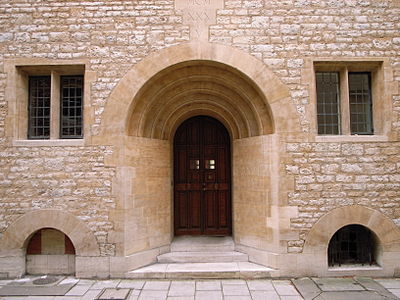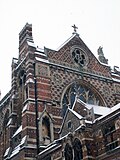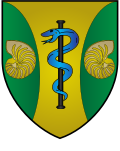| Main page | Indices | Projects |
The University of Oxford portal
The University of Oxford is a collegiate research university in Oxford, United Kingdom. There is evidence of teaching as early as 1096, making it the oldest university in the English-speaking world and the world's second-oldest university in continuous operation. It grew rapidly from 1167, when Henry II banned English students from attending the University of Paris. After disputes between students and Oxford townsfolk in 1209, some academics fled north-east to Cambridge where they established what became the University of Cambridge. The two English ancient universities share many common features and are jointly referred to as Oxbridge.
The University of Oxford is made up of 43 constituent colleges, consisting of 36 semi-autonomous colleges, four permanent private halls and three societies (colleges that are departments of the university, without their own royal charter), and a range of academic departments which are organised into four divisions. Each college is a self-governing institution within the university, controlling its own membership and having its own internal structure and activities. All students are members of a college. The university does not have a main campus, but its buildings and facilities are scattered throughout the city centre. Undergraduate teaching at Oxford consists of lectures, small-group tutorials at the colleges and halls, seminars, laboratory work and occasionally further tutorials provided by the central university faculties and departments. Postgraduate teaching is provided in a predominantly centralised fashion.
Oxford operates the Ashmolean Museum, the world's oldest university museum; Oxford University Press, the largest university press in the world; and the largest academic library system nationwide. In the fiscal year ending 31 July 2023, the university had a total consolidated income of £2.92 billion, of which £789 million was from research grants and contracts.
Oxford has educated a wide range of notable alumni, including 31 prime ministers of the United Kingdom and many heads of state and government around the world. 73 Nobel Prize laureates, 4 Fields Medalists, and 6 Turing Award winners have matriculated, worked, or held visiting fellowships at the University of Oxford, while its alumni have won 160 Olympic medals. Oxford is the home of numerous scholarships, including the Rhodes Scholarship, one of the oldest international graduate scholarship programmes. (Full article...)
Selected article
The Council of Keble College, Oxford ran the college (in conjunction with the Warden) from its foundation in 1868 until 1952. The council – a group of between nine and twelve men – has been described as "an external Council of ecclesiastical worthies", as most of the members came from outside the college, and many were not otherwise linked to the university. Keble was established by public subscription as a memorial to the clergyman John Keble. The first council members were drawn from the committee whose work had raised the money to build the college. By keeping matters relating to religion and the college's internal affairs in the hands of the council, the founders hoped to maintain Keble's religious position as "a bastion of 'orthodox' Anglican teaching" against the opponents of Tractarianism. In total, 54 men served on the Council, 11 of whom were college alumni; in 1903, Arthur Winnington-Ingram (Bishop of London) became the first former Keble student to join the council. It ceased to exist after 9 April 1952, when new statutes of the college placed full management in the hands of the Warden and Fellows. (Full article...)
Selected biography
Brian Twyne (1581–1644) was an antiquarian and an academic at Oxford. After being educated at Corpus Christi College, and becoming a Fellow of the college in 1606, he published his one main work, a history of the university, in 1608. This was designed to prove that Oxford was older than Cambridge University, and has been described by a modern writer as a "remarkable achievement for a young scholar of twenty-eight." His main accomplishment was to play a leading role in the revision of the university statutes under William Laud (Chancellor of the University of Oxford and Archbishop of Canterbury). He was rewarded by appointment in 1634 to the new position of Keeper of the Archives. In this role, he obtained a new royal charter for Oxford University to confirm its rights and privileges, and helped the university in its disputes with the city authorities. He also moved the archives into the Tower of the Five Orders (pictured) at the Bodleian Library, where they are still kept. (more...)
Selected college or hall
Green Templeton College is the newest college of the university, having been formed in 2008 from the merger of Green College and Templeton College (the first merger of two colleges in the modern history of Oxford). It is located on Woodstock Road to the north of the city centre, on the former site of Green College, and its buildings include the 18th-century Radcliffe Observatory. The college is for postgraduate studies only, with about 500 students; the Principal is the historian Colin Bundy. Green College, established in 1979 and named after the benefactor Cecil H. Green, had a focus on medicine, education, the environment and social sciences. Templeton College, founded in 1965 as the Oxford Centre for Management Studies and renamed in 1983 as a result of a donation from Sir John Templeton, concentrated on management and business studies. The college's coat of arms combines elements from its two predecessors – the Rod of Aesculapius (medicine) for Green and the Nautilus shell (evolution and renewal) for Templeton. The crest on the coat of arms displays a representation of the transit of Venus across the sun, since the 1769 transit led to the construction of the Observatory. (Full article...)
Selected image

Did you know
Articles from Wikipedia's "Did You Know" archives about the university and people associated with it:
- ... that Harrison Oxley was the youngest cathedral organist in Britain when he became organist of St Edmundsbury Cathedral (pictured) at age 24?
- ... that the Rev. George W. Bridges libelled anti-slavery activists Escoffery and Lecesne when he said they wanted to "sheath their daggers in the breasts of their white inhabitants"?
- ... that Ian Harvey, a Conservative junior minister in the United Kingdom, resigned his seat in 1958 after a sex scandal?
- ... that English musician and poet Robert Wydow is the earliest known recipient of a Bachelor of Music degree from the university?
- ... that, after being defrocked as a Church of England priest, Harold Davidson became a seaside entertainer and was killed in 1937 by a lion when he trod on its tail?
Selected quotation
Selected panorama
On this day
Events for 6 July relating to the university, its colleges, academics and alumni. College affiliations are marked in brackets.
Wikimedia
The following Wikimedia Foundation sister projects provide more on this subject:
-
 Commons
Commons
Free media repository -
 Wikibooks
Wikibooks
Free textbooks and manuals -
 Wikidata
Wikidata
Free knowledge base -
 Wikinews
Wikinews
Free-content news -
 Wikiquote
Wikiquote
Collection of quotations -
 Wikisource
Wikisource
Free-content library -
 Wikiversity
Wikiversity
Free learning tools -
 Wikivoyage
Wikivoyage
Free travel guide -
 Wiktionary
Wiktionary
Dictionary and thesaurus








Recent Comments